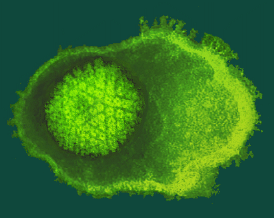SPREAD OF INFECTION
Microbes have evolved diverse ways of spreading from one person to another and from animals to people.
Many of our symptoms of disease actually represent ways of spreading from one person to another.
Infectious diseases that spread from person to person are called communicable, or contagious, diseases. These include such diseases as cholera and AIDS. Diseases that are not contagious include rabies, and tetanus. For example, rabies results from the bite of an infected animal.
Most microbes that cause communicable diseases leave the body the same way they got in-often through the nose or skin.
Microbes that cause respiratory tract infections leave the body through secretions and excretions of the nose and mouth, usually when the infected person coughs or sneezes.
Microbes spread through local populations by different routes. Some spread through air and water. Others spread through food, shared needle injections, sexual contact, or disease carriers, such as fleas and rats.
Many kinds of microbes are transmitted through the air. Droplets released when a person sneezes or another person nearby can easily inhale coughs. Crowded and unsanitary conditions increase the airborne transmission of disease-causing microbes. Microbes also can be spread by air conditioners and recycled air.
Water is a luxury in many parts of the world. About one in five people worldwide lacks access to clean, safe water for drinking, cooking, washing, or growing crops. Microbes that flourish in water polluted by human sewage and animal waste cause many outbreaks of disease. Other disease-causing microbes live in waters where people stay, in order to fish, grow rice crops, or swim.
Insects and ticks are some of the animals that carry disease-causing microbes from one host to another while remaining unaffected. Commonly called vectors, these animals adapt to changing environmental conditions, enlarge their habitat and expose humans.
In the long route from farm to table, unwanted microbes may slip into the food. In some places, sanitation problems still result in local food contamination.
Not everyone uses protection against sexually transmitted diseases. Microbes that cause such diseases can easily move among people engaged in unprotected sex.
Infected blood on a shared needle can transmit infection with such viruses as hepatitis and HIV. Sadly, some societies have limited resources, so needles must be reused for vaccines. Drug users run the risk of getting an infection by sharing needles.
